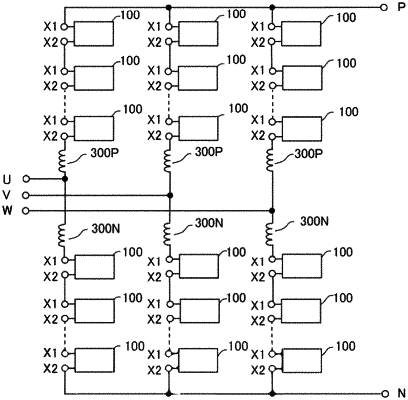| CPC H02M 7/4835 (2021.05) [H02M 1/32 (2013.01); H02M 1/325 (2021.05); H02M 7/003 (2013.01); H02M 7/49 (2013.01)] | 18 Claims |

|
1. A power conversion device in which a plurality of cell converters that perform power conversion are connected in series, each cell converter comprising:
a switching element;
a capacitor;
a main circuit conductor connecting the switching element and the capacitor to each other;
two external terminals connected to other ones of the cell converters;
a bypass portion disposed between the two external terminals and subjected to bypass connection;
a first conductor portion connecting one of the two external terminals and each of the main circuit conductor and the bypass portion to each other; and
a second conductor portion connecting another one of the two external terminals and each of the main circuit conductor and the bypass portion to each other, wherein
the first and second conductor portions are each formed in a bent shape between the main circuit conductor and the bypass portion so as to, with respect to a first direction which is a direction of a path from the main circuit conductor to the bypass portion, have a portion that extends in a second direction intersecting with the first direction,
a first portion, of the first conductor portion, that extends in the second direction and a second portion, of the second conductor portion, that extends in the second direction are disposed so as to at least partially overlap with each other in a third direction that intersects with the first and second directions, and
when current flows from the capacitor to the bypass portion, currents in a same direction flow in the first portion and the second portion.
|